Review of the Polaris PVC 0726w robot vacuum cleaner: a diligent worker with a powerful battery
Many people are wary of autonomous vacuum cleaners. Some consider the cost of the units prohibitively high, while others question their effectiveness.However, there are those who appreciate the capabilities of smart technology.
The Polaris PVC 0726W washing robot vacuum cleaner has won the trust of customers - its reasonable price, build quality and functionality have not left users indifferent.
- Spacious trash container
- Height of 7.6 cm allows you to clean even under very low furniture
- Easy to use
- Easy to care for - everything can be easily removed and washed
- Excellent battery for the money - lasts a long time and charges quickly
- Missing virtual wall
- Doesn't notice the wires, drives straight towards them and gets tangled up
- Quiet sound of error indicator
Let's take a closer look at the technical characteristics of this device and compare it with the most similar models from other manufacturers.
The content of the article:
Appearance and equipment
The Polaris brand specializes in the manufacture of various types of household appliances, laser tools, air conditioners and heating equipment. The brand's production facilities are concentrated in the CIS countries, China, Israel and the USA.
Polaris products are positioned as affordable products with high quality standards. Among home appliances, there are several models of autonomous vacuum cleaners.
The vacuum cleaner is made in the shape of a circle.The sides of the case are made of two-color plastic - black and white, the top panel is an absolutely smooth translucent beige coating. The main idea of the design is minimalism and the absence of unnecessary details.
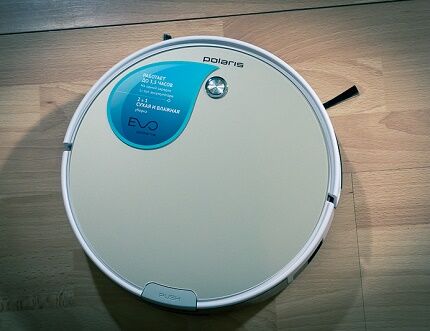
On the front of the cover there is a single backlit button for mechanical mode switching. Depending on the state of the robotics, the color of the indicator will change: solid green – active work, flickering orange – battery charging, red – error.
The bottom ends of the vacuum cleaner are slightly beveled for better access to carpets and overcoming obstacles. The front part of the bumper is framed with a rubber seal that protects the robot from collisions. The dust collector body is made of tinted plastic. There is a lever on the top edge for removing the garbage container.
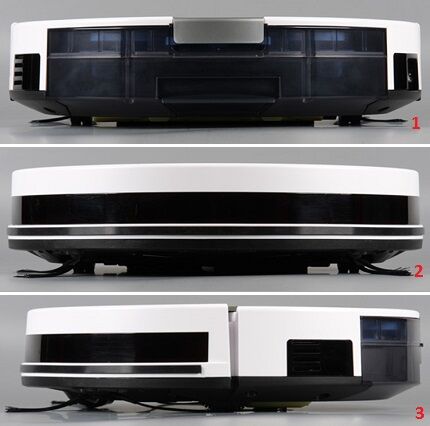
The height of the body is 7.7 cm, the distance from the floor to the lower level of the bumper is 1.7 cm - this value determines the maximum size of obstacles to be overcome.
The Polaris PVC 0726W delivery set includes all the necessary accessories and consumables, namely:
- a vacuum cleaner with an installed waste container;
- charging station, power adapter;
- water container used for wet cleaning;
- two spare side brushes;
- additional filter elements – 2 pcs.;
- Remote Control;
- a comb brush for cleaning the main brush of the unit and the dust collector;
- instructions for use and warranty card.
For the remote control, you additionally need to purchase AAA batteries, as they are not included in the package.

Design and technical characteristics
We will evaluate the design features and passport data of Polaris PVC 0726W. The following criteria deserve special attention:
- chassis device;
- cleaning brush system;
- battery type;
- volume of the dust collector and water container;
- equipped with sensors.
Chassis. The movement function is assigned to two massive wheels with active suspension. They have a diameter of 6.5 cm and are equipped with grippy rubber tires. A front roller is installed for additional support and improved maneuverability.
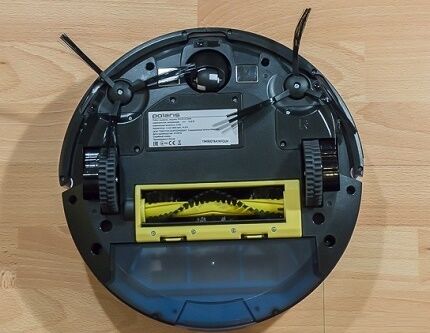
Cleaning system. Garbage capture is carried out by three elements:
- central electric brush;
- rubberized stopper;
- side brushes.
The main work is assigned to the central turbo brush. Structurally, it is a shaft with bristles. The tufts of medium-hard bristles are arranged in waves - this solution provides better capture of debris and reduces noise from the brush coming into contact with the floor.
A steel axis passes through the plastic shaft; at the end of the “cylinder” there is a sliding bearing in the form of a bronze bushing. This solution is more reliable - wound hair and wool do not lead to jamming. Rolling bearings fail faster.
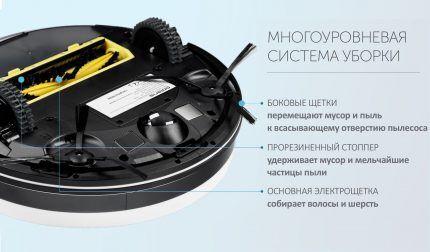
Two side three-blade brushes with hard and long bristles are responsible for cleaning the corners. Rotating leads are attached to the unit body with bolts.
The brushes and their installation locations are marked in Latin letters: R – right, L – left. They differ from each other in the direction of rotation. After several intensive cleanings, the pile of the side brushes becomes wrinkled and dirty. To restore their shape, simply remove them, rinse in warm water and dry.
Accumulator battery. The Polaris PVC 0726w robot vacuum cleaner model uses a lithium-ion unit consisting of four elements of standard size 18650. The battery capacity is 2600 mAh. This charge is enough for 3 hours of operation - this is enough to clean a room of 170 sq.m.
When the battery energy is depleted, the robot automatically returns to its base.
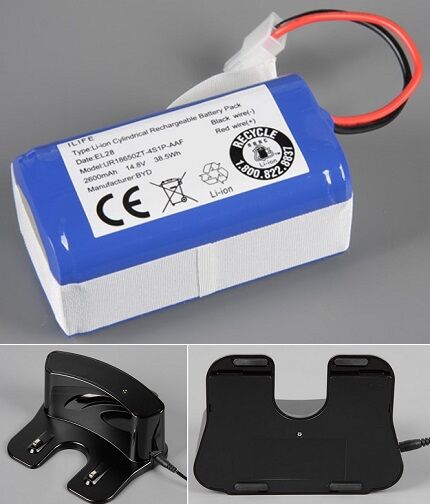
Dust collector and water tank. Despite its rather compact dimensions, the robot has a spacious container for dry waste, the container volume is 500 ml. The dust collector is equipped with a coarse filter, a foam pad and a folded HEPA filter. According to the manufacturer, multi-stage filtration purifies the air flows circulating through the vacuum cleaner by 98%.
The dust collector can be easily removed from the unit - the high front partition prevents accumulated debris from spilling out. The top lid tilts 180°, which is convenient when emptying it.All elements of the container can be washed, but they must be dried before putting them back.
For wet cleaning, instead of a dust collector, a water tank is fixed and a napkin is attached to the bottom of the container. The terry cloth is held in place by two elastic bands and Velcro. Fully filling the container lasts for 30 minutes.
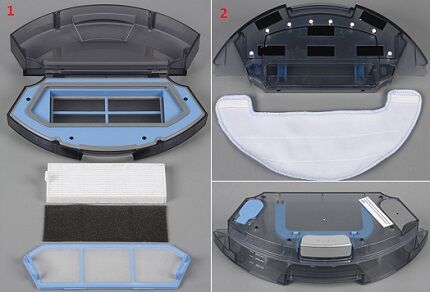
During washing, the rag gradually becomes wetted - the liquid seeps through micropores in the inserts at the bottom of the tank. This tank has a small compartment for dry debris, swept by the central brush. During wet cleaning, dust is not absorbed.
Availability of sensors. The robot is equipped with two groups of sensors:
- anti-fall sensors;
- IR detectors that prevent collisions.
Infrared anti-fall sensors. Three sensors are installed at the bottom of the vacuum cleaner. The determinants prevent the robot from falling down the steps. In some models, IR sensors block the operation of the unit on a black surface, perceiving it as an insurmountable obstacle, an abyss. Polaris PVC 0726W continues to move on a dark floor.
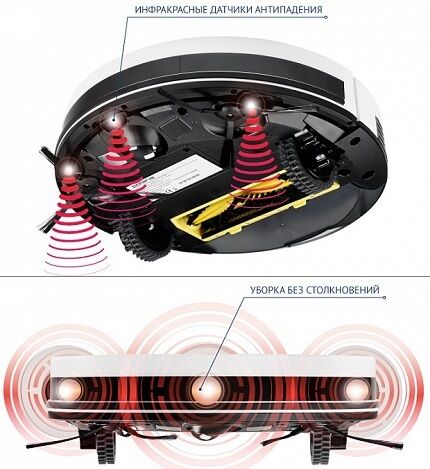
The received signal slows down the robot's movement at a distance of 1-4 cm from the obstacle. The unit carefully moves around furniture.
To control the vacuum cleaner and select the operating mode, there is an IR remote control with an information screen. The display shows the current time and the programmed start of cleaning.
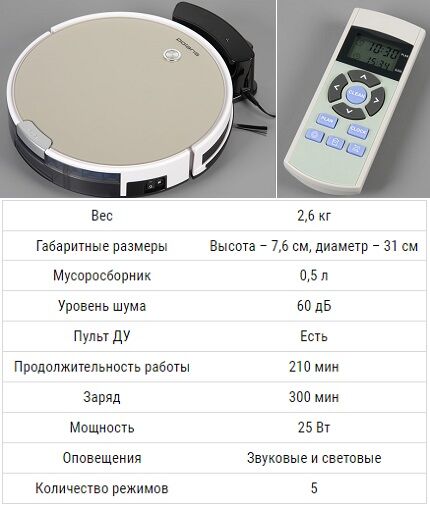
The estimated service life declared by the manufacturer is 3 years, the warranty period is 24 months.
The video provides a description of the device and a demonstration of the capabilities of the autonomous robot PVC 0726W:
Robot functionality
The model supports five cleaning modes:
- Auto. The vacuum cleaner moves in a straight line; when it collides with furniture or other objects, the unit changes its direction vector. Cleaning continues until the battery is discharged, after which the vacuum cleaner returns to the base. The mode can be selected in two ways: the “Auto” button on the robot panel, and the “Clean” button on the remote control.
- Manual. Control the autonomous assistant remotely. You can manually direct the device to the most contaminated areas - the remote control has left/right buttons.
- Along the walls. When working in this mode, the robot pays special attention to corners. The unit moves along four walls.
- Local. The circular motion of the vacuum cleaner, the intensive cleaning range is 0.5-1 m. You can move the robot to a contaminated area or direct it using the remote control, and then press the button with the spiral icon.
- Time limit. Suitable for cleaning one room or compact apartments. PVC 0726W performs a normal pass in automatic mode, operation limit is 30 minutes.
To select the last function, you must double-click the “Auto” button on the device body or the “Clean” button on the remote control.

User rating – pros and cons of the vacuum cleaner
Polaris PVC 0726W is in demand among consumers due to its loyal pricing policy and product compliance with the stated characteristics. The robot copes with the assigned tasks, so most users respond positively to the model.
The main arguments in favor of PVC 0726W:
- Duration of work. The robot is a universal assistant. The model is recommended for cleaning small apartments and spacious houses. In one run, the vacuum cleaner is capable of cleaning up to 150-170 sq.m.
- Moderate noise. The operation cannot be called silent, but if you are in the next room, the functioning unit is practically inaudible.
- High quality cleaning. Users have no complaints about the cleaning efficiency. The test drives carried out showed good results: in 30 minutes the device cleans 93% of debris, in 2 hours – 97%.
- Easy to maintain. Thanks to the spacious dust collector, you don’t need to empty the container very often. The tank can be easily removed and installed back.
- Ease of control. The kit includes a Russian-language manual with a clear description and instructions for using the robot. There are no difficulties with control.
An additional plus is good parking. When the charge level drops to a minimum, the unit quickly finds a station. The robot parks without any problems the first time, without moving the base.
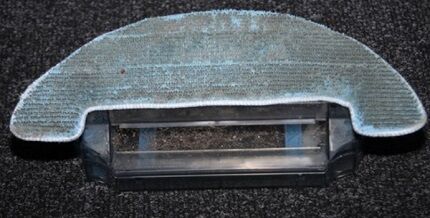
Users have identified a number of shortcomings in the robot’s operation:
- Long battery charge. It takes about 5 hours for the vacuum cleaner to restore its functionality.
- The need for surface preparation. The unit does not have sensors against wire wrapping, so before starting you need to check the room for scattered extension cords, ribbons, etc. Some note that the robot can go under raised corners of linoleum and carpets.
- Garbage in the corners. Despite the special mode of moving along the wall and the presence of side brushes, the vacuum cleaner does not completely clean hard-to-reach places.
- Getting stuck under furniture. Due to its compactness and low height, the unit fits under the refrigerator and cabinets. If space allows, the robot moves and exits freely, but sometimes it gets stuck. If it gets into a dead end situation, the vacuum cleaner automatically turns off.
Some users miss the “virtual wall” module and displaying information about the battery charge level.
Other Polaris brand offerings
The model in question belongs to mid-price products. The Polaris line of robotic vacuum cleaners includes budget representatives and more expensive products.
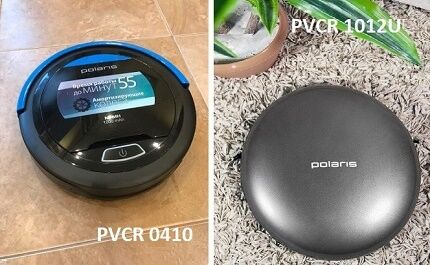
Competitive advantages of the 0726W vacuum cleaner in comparison with cheap robotic vacuum cleaners:
- increased dust collector volume – from 0.2 to 0.5 l;
- improved battery parameters: PVCR 0410 uses a Ni-MH battery with a capacity of 1000 mAh, and PVCR 1012U uses a lithium-ion battery with a capacity of over 2000 mAh;
- program duration – the maximum continuous operation time of budget models is 55 minutes;
- expanded functionality – the presented units of the PVCR series are not intended for wet cleaning; they cannot be programmed and controlled by remote control vacuum cleaners.
The more expensive model 0920WF Rufer outperforms the Polaris PVC 0726W in the following indicators: the presence of a “virtual wall”, an additional mode – Zig-Zag movement, and equipped with an informative display.
However, the 0920WF Rufer has a less capacious battery (2000 mAh), the operating period is 100 minutes. Estimated cost – 370 USD.
We also recommend that you familiarize yourself with the rating of the best models of robotic vacuum cleaners from Polaris. Read more - read Further.
Comparison of vacuum cleaners from competitors
For a detailed assessment of the qualities and capabilities of the model in question, let’s compare it with products from competing companies. As a basis for choosing robots for comparison, we will take the main responsibility - the ability to carry out dry and wet cleaning. To really evaluate the difference in technical equipment, we will analyze vacuum cleaners from different price segments.
Competitor #1 – Xiaomi Xiaowa E202-00
The Xiaomi Xiaowa E202-00 Robot Vacuum Cleaner Lite robotic vacuum cleaner attracts with its affordable price and fairly wide range of functions. It, like its competitor Polaris brand, not only absorbs dust, but can also perform wet cleaning.
The main feature of this Xiaomi model is the ability to integrate into the system smart home. The robot can be part of the Xiaomi Mi Home and Amazon Alexa ecosystem. The vacuum cleaner is controlled using a smartphone using the Wi-Fi communication protocol. Owners have access to a timer function and programming by day of the week.
Xiaomi Xiaowa E202-00 Robot Vacuum Cleaner Lite can build a map of the room and calculate the time required for cleaning. It detects obstacles in its path using built-in sensors.
With a charged battery it works for 90 minutes; when the charge is depleted, it rushes to the parking station to get a fresh dose of energy.
The volume of the box for accumulating collected dust is 0.64 liters. When switching to wet cleaning, the dust collection box is removed and a sealed container of similar capacity is installed, which is required to supply water to microfiber cloths. The device is protected from impacts by a soft bumper.
Competitor #2 – Everybot RS700
The model, which belongs to the middle price segment, cleans the floor in five different modes. Works with a charged battery for only 50 minutes, after which it must be manually installed to recharge. As an option, it can be equipped with a parking station. It will take 2 hours and 30 minutes for the device to receive a fresh dose of electricity.
Everybot RS700 is controlled using buttons located on the front side and using the remote control. The unit is equipped with a soft bumper that absorbs accidental collisions. Infrared sensors detect obstacles in the robot's path. This is the quietest model considered. Emits only 50 dB.
To perform wet processing, the robot is equipped with two rotating nozzles with microfiber working parts. Water is automatically supplied from a pair of boxes installed inside the device, holding 0.6 liters. The dust collector for dry cleaning is equipped with an aquafilter.
Competitor #3 - iRobot Roomba 606
Another competitor to the Polaris PVCR 0726w robot is the iRobot Roomba 606. It performs dry cleaning using the iAdapt navigation system. To collect debris, you can use the electric brush that comes with the kit; it also has a side brush. AeroVac Bin 1 container serves as a dust collector.
With a charged battery, the robot works diligently for 60 minutes, after which it automatically returns to the charging station.To conduct the next session, he needs to charge a Li-Ion battery with a capacity of 1800 mAh.
The iRobot Roomba 606 is controlled using buttons located on the body.
Among the advantages of this model, the owners cite fast charging, reliability and excellent cleaning results - thanks to the electric brush, the robot can even collect animal hair. Users also respond positively to the build quality.
As for the minuses, the first place here is the weak equipment - there is no magnetic tape to limit the area to be processed, there is no control panel. The downside is the rather noisy operation of the vacuum cleaner.
We reviewed more models of robotic cleaners from this brand in next rating.
Conclusions and best offers on the market
Polaris PVC 0726W is a washing vacuum cleaner in the mid-price segment. The model is in demand and fully justifies the money spent on the purchase. The most obvious drawback affecting ease of use is the lack of a “virtual wall”.
Please write comments in the block below. Perhaps you have experience using the Polaris PVC 0726W device? Share it with our readers, tell us what advantages and disadvantages were noticed when working with a robot vacuum cleaner.
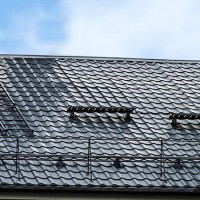



It seems to me that robotic vacuum cleaners are such stupidity, well, they can’t clean on par with a regular vacuum cleaner, not to mention washing vacuum cleaners or even vacuum cleaners with an aqua filter. And the Polaris technology is a very budget option, and not the best, the manufacturers of which are trying to copy something from well-known brands, but it doesn’t work out well. Can anyone convince me of this: who used it and was very pleased?
I also doubted it, but now that I’ve been using it for more than six months, I can say that it’s a completely normal thing. Yes, he cleans worse than a good housewife, but with this robot I clean myself only one day a week on weekends. We turn it on once every 2-3 days - it collects dust, and after dry cleaning it wipes the floor with a damp cloth. There are problems with cleaning in corners and under furniture, but the entire center is clean.
As for the Polaris assembly - yes, this model often has problems with the “brain” malfunctioning, but so far we’ve been lucky.
Perhaps in ancient times retrogrades also greeted the appearance of a vacuum cleaner. So what? And everything is cleaned well with a broom; it’s unlikely that your car can do the same.
It's the same with robot vacuum cleaners. People, without understanding, classify them as toys. And in vain, progress does not stand still.